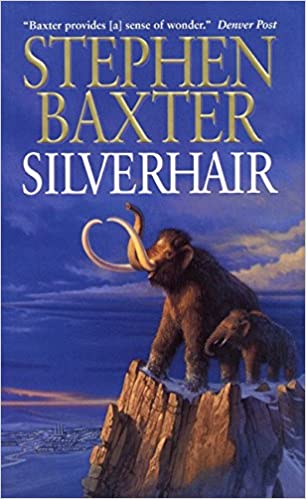How is the world viewed through nonhuman eyes? Authors have looked at the world from the perspective of animals since at least as long ago as Aesop, often with a lesson to tell us about human behavior and human nature. When not providing a direct and specific message (Animal Farm, for example) these kinds of stories best serve as windows into an alien perspective on the world. An account of the world through an animal’s viewpoint gives a fresh view of the world and provides food for thought on how we interpret the world and what our assumptions are in the relationship between humans and the animal kingdom.
Stephen Baxter’s Silverhair presents the world through the eyes of woolly mammoths. The book does a good job of creating a psychological profile of mammoths, framing their experience of the environment, their relations with each other, and their dealings with other animals in distinctly nonhuman terms. The smallest details of mammoth physiology and diet are used in particular ways to construct the story of a female mammoth named Silverhair and her efforts to preserve her family. The plight of aged mammoths and the difficulties surrounding birth and the care of calves figure prominently in the novel’s events and weigh heavily on the decisions made by the mammoths and the direction that the plot takes.
In addition, Baxter paints an extremely realistic picture of the Arctic, combining an encyclopedic level of detail with compelling characterizations to bring even the least significant aspect of the environment to life. Silverhair is as much an educational exercise as a good adventure story.
Silverhair tells the story of a small group of mammoths as they struggle to survive in the face of a changing climate on a distant and unnamed island in the high Arctic. Silverhair is a young female who spends much of her time wandering across the island, exploring and looking for the other mammoths who once lived there. Concerned about her family’s survival, she leaves her family to find allies to help them. She is assisted in this effort by Lop Ear, a young male with a striking intelligence and a way of looking at things unique among the mammoths. Silverhair and Lop Ear’s adventures lead to a harrowing encounter with a mysterious new invader (known only as The Lost, the greatest enemies remembered in the ancient mammoth story cycles).
A lack of water and the danger presented by the new invaders convince Silverhair and the family’s matriarch, Owlheart, to lead the mammoths beyond the Mountains at the End of the World (the northern border of their lands on the island) in a desperate attempt to find a new and secure home. In the process, Silverhair must stretch her mind to encompass new ideas and new allies in order to save her family.
In many ways, Silverhair closely parallels another novel told about an animal struggling to find a new home for its family — Watership Down. Several characters are strikingly similar (Silverhair for Hazel, Lop Ear for Fiver, Eggtusk for Big Wig) and the stories told about the legendary Longtusk are reminiscent of the rabbits’ stories of El-ahrairah. The mammoths aren’t cookie cutter duplicates of the rabbits in the earlier novel, but there are close parallels in their personalities and in their function in the novel.
This isn’t a weakness; an epic narrative of a people’s journey to a new home requires certain types of characters to drive the plot. The fact that Stephen Baxter uses characters and a plot that is similar to Watership Down is more a result of telling the same type of story than an example of closely imitating an earlier work.
One point of warning — though Silverhair has been pitched by Baxter as a children’s book, and the overall storyline is suitable for children, the violence described in the mammoth’s struggles against the new enemies who appear on the island is much too graphic for Silverhair to really be considered as a children’s novel.
Richly imagined and containing enough surprises to refresh the familiar storyline, Silverhair is a convincing description of the lives of mammoths and how (assuming a high level of intelligence) they would address the challenges represented by new enemies and a declining environment. The mammoths’ struggle to survive in the face of a changing world is gripping and compelling. The characters are well enough developed for the reader to really feel for them. The writing generates a lot of empathy when the mammoths are particularly suffering. Both the small joys and the ever-growing sorrows of their existence have a telling emotional value for the reader.
Stephen Baxter’s website is here.
(EOS, 2000)

